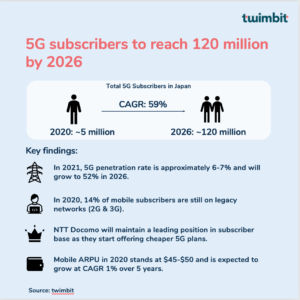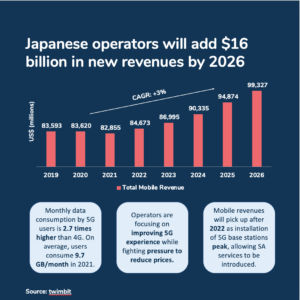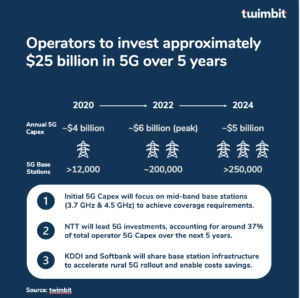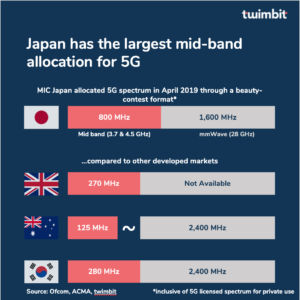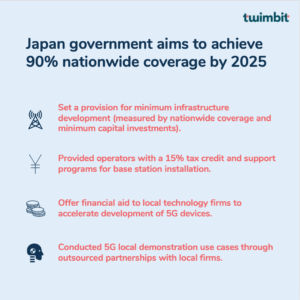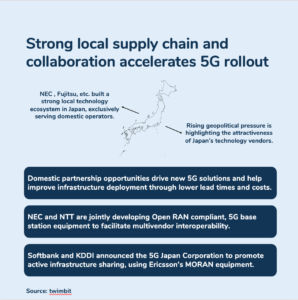Japan has long been a leader in the wireless innovation space, pioneering 1st and 2nd generations of cellular networks. It aims to do the same with 5G. Being an early promoter and adopter of 4G LTE less than a decade ago, Japan is slightly behind its regional neighbours such as South Korea and China, in terms of 5G rollouts. However, Japan is definitely in a good position to make strong progress. From our study of the 5G ecosystem in Japan, we expect pro-5G policies from the government, smooth spectrum allocation and a strong local ecosystem of vendors and telecom operators, to accelerate and bring 5G to new heights. Check out some of the other key highlights of 5G in Japan:
1) Japan has one of the largest mid-band spectrum allocations for 5G among the developed markets
In April 2019, three of the largest mobile operators in Japan — KDDI, NTT Docomo, SoftBank, and new entrant Rakuten Mobile were allocated new 5G spectrums by the Japanese Ministry of Internal Communications (MIC).
In total, Japanese operators hold 600 MHz (except for SoftBank and Rakuten) in the mid-band (3.7 GHz, 4.5 GHz) and 1600 MHz in high band (28 GHz) frequencies, respectively. Overall, this reflects a different strategy to the 5G spectrum allocation in China, which complements the mid-band with a low band frequency. As compared to regional neighbours such as South Korea (280 MHz) or China (520 MHz), the ‘land of the rising sun’ has a relatively high allocation in the 3.7 & 4.5 MHz spectrum, amounting up to 800 MHz for 5G use.
All existing 4G spectrum bands, including 700 MHz, 800 MHz, 900 MHz, 1.5 GHz, 1.8 GHz, 2.1 GHz (FDD), 2.5 GHz and 3.5 GHz (TDD), have also been made available for 5G NR deployment. This enables operators to conduct trials that can expedite 5G services deployment, specifically for enterprise use cases.
The MIC allocated the 4.6 GHz – 4.8 GHz and 28.2 GHz – 29.1 GHz bands for local private services, known as Local 5G. This was granted to 13 private and public organisations, including Fujitsu and Tokyo University and will mainly be in use within narrow and limited spaces such as the specific building, factories, and farmland area.
Also, the 4.9 GHz – 5.0 GHz, 5.15 GHz – 5.35 GHz bands are currently open for unlicensed use in Japan. Additionally, the government has allocated spectrum in the 5.15 GHz– 5.35 GHz for indoor use. Unlicensed high bands (24+ GHz) between 26.6 GHz– 27 GHz, 39.5 GHz – 43.5 GHz, 57 GHz – 66 GHz, and 7.025 GHz – 7.125 GHz are currently under review for commercial use.
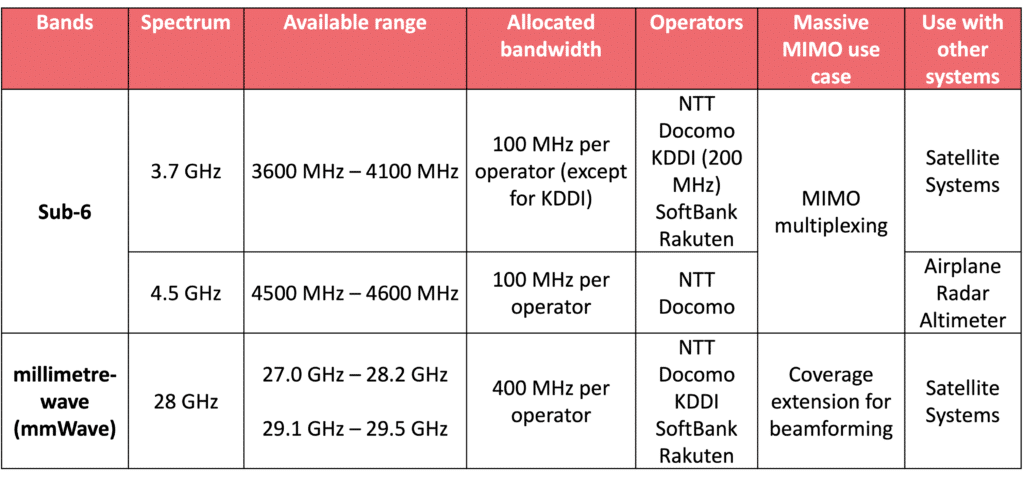
Table 1: 5G spectrum allocation
Source: twimbit, MIC
2) Strong governmental support to achieve 90% nationwide coverage by 2025
The MIC assigned 5G spectrum in a beauty-contest format compared to auctioning licenses to the highest bidder as seen from regional peers. This method of spectrum allocation reduces financial pressure on telecom operators to monetise 5G services. In addition, the minimum coverage enables Japan’s society to enjoy faster market services as operators work towards completing the country’s first nationwide network (with a 63% coverage) by 2023.
Operators also need to have provision for minimum infrastructure investment requirements to roll out commercial deployment by 2024. A detailed business case accompanies each application, which includes plans on (but not limited to):
- Maintaining safe and reliable facilities
- Infrastructure funding
- Opening networks up to MVNO
- Base stations and optical fiber installation
- Safety measures against interferences between existing radio licensees

Chart 1: Minimum 5G coverage and investment by an operator
Source: twimbit & KPMG
In total, the minimum 5G investments by these four Japanese operators will amount to USD14.6 billion. According to recent press releases, the operators expect this to increase as they start rolling out and accelerating 5G network infrastructure deployments, specifically on building 5G base stations. (Source: MIC)
The establishment of the national 5G networks is a high priority for the Japanese government. For instance, the aim behind launching the 5G pre-service in 2019 was to test out its speed and capacity, as seen in the 2019 Rugby World Cup and the Tokyo 2020 Olympics Games. MIC has also announced a target of deploying 280,000 base stations by March 2024 in the release of Master Plan 3.0 on the Regional Development of ICT Infrastructure. This plan specifies the need to have base stations installed in half of the national grid of 4,500 10km-by-10km cells covering the nation.
Under a tax incentive program approved in February 2018, the Japanese government provides operators with a 15% tax credit to promote 5G investments, including industrial and agricultural applications. For rural and sparsely populated areas, a government support program is available to aid operators in their base station installation projects.
Another government aid from Japan’s Ministry of Economy, Trade and Industry (METI) worth around USD640 million will be available to local firms. This includes electronic makers and CSPs like NEC Corp and Fujitsu to accelerate the development of devices for 5G base stations. Having this extra aid will enable equipment makers to rebuild economies at scale, strengthen cash flows, and support investments towards new technology development.
To expand its smart city infrastructure, the Japanese government has also announced that operators can install 5G base stations on 208,000 traffic lights across the country. It proposed that the costs of using the traffic lights for 5G deployments be shared among operators and local administrations. These smart traffic lights will come with embedded communication functions for mass traffic data collection and processing as well as for emergency communication. (Source: Nikkei Asia)
MIC has also conducted demonstrations in a development project to realise local 5G use cases involving several sectors — agricultural, marine, manufacturing, automotive, transportation, tourism, e-sports, disaster prevention, security, telemedicine, and remote communication.
3) Operators expect to invest approximately USD25 billion in 5G over 5 years
As operators are required to achieve a coverage threshold as part of the spectrum allocation conditions, capital investments are starting to pick up in 2021 and will peak in 2022 as operators start deployments of cloud-native 5G standalone (SA) core networks. 5G CAPEX will slowly decline in the later stages of the forecast period, as operators start to reduce CAPEX spend on network deployments and enjoy the cost-savings of new-generation 5G SA cloud-native deployments.
In 2020, estimates indicated that operators had spent around USD4.1 billion in total 5G CAPEX. This cumulative figure will increase to over USD25 billion over the next five years. NTT, KDDI and SoftBank will lead the 5G investments, accounting for over 85% of the total 5G operator CAPEX expected between 2021 – 2025. Among the three operators, NTT will account for 37% of the total 5G investments. The sharing of base station infrastructure between KDDI and SoftBank will allow both operators to save on network deployment CAPEX in the nascent stages. (Source: twimbit)
Most operators in Japan are only setting installation targets of up to 2022, except NTT Docomo. As of 2020, the four operators deployed over 12,000 base stations consisting of over 65% of mid-band frequencies (3.7 GHz and 4.5 GHz) compared to 35% of those in the mmWave (28 GHz) range. Despite the heavy focus on mid-band base stations, Japan has seen a three-fold increase in 5G mmWave base stations in 6 months (from September 2020 to March 2021), from 2,300 to 8,100 base stations. (Source: Qualcomm)
Rakuten has started offering 5G services in 2020 but is implementing the low-cost route, initially deploying 5G NSA architecture using its existing 4G base stations with 5G NR radios. The e-commerce group claims to be able to build 5G base stations at 10 to 20% of NTT’s total cost.
It started deploying 16,000 5G antennas and base stations that NEC developed. This allows Rakuten to leverage local expertise, enabling its strategy to build a low cost, cloud-native interoperable vRAN. The same partnership with NEC also builds the foundation for the group’s 5G SA plans. Leveraging on NEC’s expertise as a system design house, Rakuten can collaboratively produce 5G SA at half the cost compared to traditional vendors such as Huawei, Ericsson, or Nokia. (Source: Rakuten)
With the currently announced plans, there will be a peak in 5G base stations installation in 2022 as operators work towards commissioning 5G SA services in the shortest time possible. This is in parallel with achieving MIC’s Master Plan target for 5G base stations, in anticipation of subscribers’ migration towards 5G services.
4) Japan will have more than 50% of its total mobile subscribers in 5G by 2026
Japan can expect 5G subscribers in 2021 to make up 6-7% of its total mobile subscription base. This figure translates to roughly 14 million and looks to grow at a CAGR of 3% to roughly 120 million in 2026, giving a penetration rate of 52%. 4G subscribers will take up most of the market until 2025. The country operator leader, NTT Docomo, will maintain a foothold in the number of mobile subscribers, even in the 5G domain, as they start to offer cheaper 5G mobile plans in response to the changes in government sentiments. (Source: twimbit)
As operators started to deploy 5G services in 2020 through NSA (non-standalone) deployments models, existing customers started migrating and subscribing to newer services that promise speeds of up to 4.1 Gbps and higher. Hence, 4G subscriptions will start to decline in 2022. Legacy network (2G and 3G) subscribers in 2020, accounts for 14% of mobile subscribers in Japan as the users are customers in rural areas of Japan, utilising traditional mobile services. Eventually, operators will experience a migration of 2G and 3G subscribers to newer services in 2024 as they complete the decommissioning of legacy networks and phase out from circuit switching.
Coupled with the operators’ efforts in testing and looking for collaborative partnerships for 5G SA deployments, 5G will take over as the dominant mobile technology in 2026. Hence, established operators like NTT Docomo have made vendor arrangements for 5G SA, while greenfield Rakuten has begun demonstrating containerised 5G SA core solutions. However, despite these efforts, operators see slow adoption of 5G services in 2021.
5) ARPU in Japan to experience minimal increase despite 5G subscriber growth
Compared to regional neighbours like China and Korea, which had reported a significant growth in ARPU and mobile subscribers due to 5G, Japan operators expect the 5G rollout to have minimal impacts on their ARPU. The mobile ARPU currently stands at USD45 – USD50 and is expected to grow at a CAGR of 1% over the next five years. (Source: twimbit)
One of the first decisions taken by Japan’s Prime Minister Yoshihide Suga was to advocate for operators to reduce mobile services prices. This was to increase market competitiveness for MVNOs, encourage widespread use of eSIM services, and simplify mobile price plans further.
Therefore, operators have been cautious with pricing their new services. Instead, they lowered cancellation fees and handset subsidies and even announced plans to offer cheaper subscription plans. NTT Docomo, under its Gigaho brand, reduced monthly 5G services fees by ¥1,000 (USD9.11). Other operators such as KDDI and SoftBank have also tried to undercut market offerings with cheaper mobile plans, including those with unlimited data and using both 4G and 5G.
This governmental pressure has created a modern-day price war as Japan tries to cut monthly mobile services fees. As 5G services attract more attention, newer operators such as Rakuten have tried to capture new subscribers by introducing significantly cheaper and even free plans for light users. The telco’s UN-LIMIT VI plan offers customers access to 5G at up to 50% less cost than major operators. In addition to rolling out cloud-based 5G for no extra cost to customers, Rakuten has also offered a complimentary first year of the Rakuten Mobile service to the first 3 million subscribers. (Source: Rakuten)
6) Operators will add USD16bil in new revenues by 2026
The mobile revenue in Japan will experience a growth phase in the coming years, rising at a CAGR of 3% from USD82.8 billion in 2021 to USD99.3 billion in 2026. The increase in total mobile subscribers drives this growth (Source: twimbit)
The total mobile subscriber base will expand from 196 million in 2021 to 230 million in 2026. The recorded number of mobile connections in Japan was equivalent to over 150% of the total population, indicating that an individual is likely to have more than one mobile device. (Source: twimbit)
Concurrently, as the total subscriber base grows, Japan’s averagely monthly data usage is also expected to increase by 2.7 times from 4G to 5G, accelerated by the rise in digital content consumption and low latency applications. (Source: Opensignal)
In 2021, the average monthly data consumption amounts to around 9.7 GB regardless of 4G or 5G subscriptions and will look to exceed 20 GB in 2026. (Source: twimbit) This trend is in line with the report that NTT Docomo made on the surge of the daytime data volume of up to 40% due to rising remote education purposes in 2020. The increase in smartphone penetration and higher value data packs offered by operators exacerbates this spike.
Operators are introducing 5G-compatible devices that allow customers to customise and manage data plans to accommodate heavy usage. Notably, NTT Docomo launched the 5G-compatible home router in August 2021, which requires no on-site installation. In addition, NTT is taking an all-rounded approach to cross-sell and attract as many customers as possible to adopt 5G, as non-NTT customers will still be able to use its new home router.
7) Strong local supply chain accelerates 5G rollout
Japan has a well-developed local supply chain consisting of domestic technology providers such as Fujitsu and NEC, who develop 5G technology. These local technology players almost exclusively operate in Japan’s domestic market but have established themselves in the international arena. NEC and Fujitsu only control 1% share in the global share of the 5G market and are therefore strongly inclined to serve local operators in deploying 5G services. (Source: Nikkei Asia)
Amid the geopolitical pressure on Chinese vendors, local technology vendors in Japan are gaining more attention as reliable alternative partners for 5G in the international market. For instance, the UK is partnering with NEC for 5G broadband on the back of banning Huawei equipment from its network. On another note, Rakuten is helping the Indian government develop its 5G network hardware.
NEC and NTT announced a collaboration that will see the joint development of 5G base station equipment which are Open RAN compliant, along with other high-quality and low-cost IT products. Besides driving open architecture in the local telecommunication industry, the alliance aims to realise the Innovative Optical and Wireless Network (IOWN) initiative. NTT has also acquired a 4.8% stake in NEC to facilitate joint R&D plans and global marketing for 5G, DSPs and other optical and wireless devices.
Besides partnering with local vendors, operators in Japan take a collaborative approach towards accelerating 5G coverage and consumer services. For example, SoftBank and KDDI announced an equally owned joint venture that will promote 5G deployment in rural areas, known as 5G Japan Corporation. The focus is to encourage infrastructure sharing based on mutually owned base station assets and will involve joint construction design and management.
Both operators also recently announced the use of multi-operator RAN (MORAN) equipment from Ericsson, which will allow them to share networks while maintaining proprietary operations and management capabilities. Instead of sharing passive network components, both these operators have a greater appetite for active sharing (like the situation in China and Europe). The use of Ericsson Radio System solution, which includes baseband, radio, and transport, along with spectrum sharing and Ericsson’s Uplink Booster, will bring greater cost benefits as well as a faster and denser 5G SA network deployment. The shared RAN equipment can extend 5G mid-band coverage with improved uplink throughput and efficiently support multi-spectrum use (4G LTE, 5G NR on both FDD and TDD).



